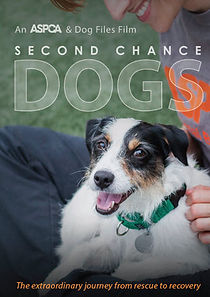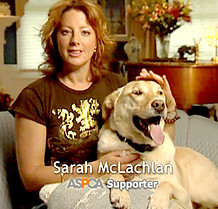Madison Jaffe

"Hurry, He's in Critical Condition!"
The ASPCA (American Society for the Prevention of Cruelty to Animals) is the most widely known organization for advocating the prevention of cruel treatments towards animals.
Their slogan is “We are Their Voice,” which automatically makes
the organization a group effort, with the key word ‘we’ being
included. ‘We’ is used to infer that the ASPCA not only consists of
the staff members, but also the recipients who are involved in any
of the genres. The slogan helps in directing the audience towards
a certain mindset, coming to a realization that the animals cannot speak for themselves. The society's goal is to contribute to the animals since animals are the ones in dire need of help. This slogan helps emphasize the harsh lives some animals will live if no contribution was to happen. The animals are put into a vulnerable state through the eyes of the audience due to the slogans wording.
The ASPCA is most likely known for their extremely sad commercials, which have left a lasting impact on most of the viewers. Once In The Arms of an Angel comes on, everyone in the audience already knows that the commercial is going to be the one from the ASPCA. Sarah McLachlan comes in at the end of the commercial and asks for donations while petting a happy dog, which seemingly appears to be one that has been saved through the society. This commercial is a very effective way of promoting the campaign against cruelty to animals. Images and videos are shown of suffering dogs and cats, making the visual experience a hard one to watch. However, even though the commercial is very unpleasant, it leaves a lasting impact on the viewer.
The ASPCA uses commercials as their main form of gaining empathy towards the cause. The information given in these TV commercials are directed to trigger one’s emotions and gain sympathy towards the animals. The ASPCA includes the strategy of showing graphic images and sad music to use the appeal to pathos. The use of pathos persuades the audience that they should help the animals in need by donating money and making a contribution instead of just sitting around on a couch wasting time. This triggers the person since they will subliminally think that they could be helping make a positive impact on the world, but instead they are being unproductive. A mellow toned voice is used in the commercial to emphasis the care that the ASPCA will put towards helping the animals and also to symbolize that Sarah McLachlan, the mellow toned voice, is a trustworthy person, therefore, you should take her word about what she is saying. The heart pulling words that come from these ASPCA commercials help with keeping the audience's attention directed toward the screen. Statistics are provided to show the effect of how common animals truly are put into abusive situations. The numbers provided put the amount of cruelly treated animals into a more real-life perspective. The point of view being used is in second person, a direct reference that the person listening is the sole solution to reversing the current problems.
Second Chance Dogs is a movie that was produced by the ASPCA to help show a more in-depth rehabilitation regimen. The movie specifically clarifies where the money is going
and how it is being used to offer the animals the life they deserve. The movie is
primarily directed towards more of an animal friendly audience, since the society
has a lot of involvements which circulate around the prevention of a cruelty life for
animals. Second Chance Dogs is not something that is stumbled upon, such as a
commercial or a social media post, but is still highly accessible, since it is offered
on Netflix. The viewer would have the ability to opt into watching the movie to
learn more about what the society stands for. By this point, the viewer would
generally know the expectations of the society. This movie is not as much about
raising awareness, but going deeper into how they actually rehabilitate the
animals into a healthy lifestyle. Second Chance Dogs was originally aired on
Animal Planet, a channel whose majority of the audience is either a fan of or interested in animals. By offering Second Chance Dogs on Animal Planet, it helps
to target the movie towards the appropriate type of
audience. The movie involves specific cases of animals
being rescued, going through the process to cope with
fearful situations, and being adopted into a healthy home.
This technique appeals to the use of pathos and portrays
that every animal could have a happy ending similar to the ones shown if ‘you’ were to donate. Movies, in general, are able to create a storyline, allowing the viewer to become more emotionally attached to the characters involved. Movies often trigger an emotional attachment to something that had previously happened or could relate to the person's life. This trigger creates a good movie, but also a memorable movie for the fact that it makes a connection within the person watching.
Social media is used on a day to day basis and is typically how people keep up to date with most information in today’s world; it is seemingly the easiest way to reach out to the most diverse amount of people. Social media is also relatively cheap and requires much less thought when compared to some of the other genre types. The truth is that a large majority of the people who would have the funds to donate would also have the accessibility to social media. A wide ranged audience is being targeted in this genre form. The post on social media, whether it is Facebook, Instagram, or Twitter, would typically involve a video or a picture along with a text caption explaining what is happening in the image above. Due to the pictures that may be posted of the suffering animals, the image would draw in the attention of the user and would in turn make them read the text caption below. By seeing the distressed animals, people are more inclined to direct their attention to the ad and possibly make donations to help. The information involved in the text is very straight to the point and not very detailed, informing the audience on only what is necessary to make the post understandable.
A poster campaign is similar to social media, in the way that it is also not very informative and is directed towards a large audience. This form of advertisement is easily stumbled upon and is used more for raising awareness rather than calling for an action to take place. Poster campaigns are typically simple and involve very limited text, but still aesthetically appealing enough to draw in the attention of the bystander. A picture of a cute animal would attract the attention of the bystander and the text would inform them about the society. For further action, the audience could visit a website or call a specific number which would be listed at the bottom of the poster. Poster campaigns for the ASPCA may be located in adoption centers, a pet supply store, or even outside of an animal-mill supplied pet store. The main purpose of these locations would be to target an audience that has some closer relation to animals. For example, if someone were to walk into a mill supplied pet store, they might think twice about the breeding conditions and opt to go adopt an animal from a shelter.
Conferences and panels are one of the most in-depth and interest-based type of genres offered in reference to the ASPCA. Conferences are a better way of connecting with the audience because it is a face to face interaction. Being able to see the speakers in their true form, along with the vibes in the room, allows a better bond to be made. The audience who would go to either of these genres would typically feel passionate towards or be involved in the cause prior to attending. The audience would already know about the ASPCA’s morals and goals they want to achieve. The introduction of an elite panel, one full of animal activists who have accomplished many achievements, would offer up the fact that the ASPCA has credibility. If the credible people are willing to represent the name of ASPCA, then that would in turn also make the ASPCA credible. The style may be more of a conversational tone if it were a questioning panel or may also be very conservative if it is a lecturing type of conference. Typically the goal of this genre is to get the audience more involved than they already are. Promoting the action of spreading the word about the ASPCA and also becoming activists for the cause would help the animals the greatest amount.
The ASPCA has an easy and automatic way of triggering people's emotions,
simply because it is in relation to animals. Animals are often a weak spot for
people and therefore, the ASPCA can easily use the appeal to pathos within
their genres. Each genre targets a different audience and allows different
people to become involved. Not everybody has the time and passion to attend
a conference, but may still want to contribute to the cause. Making movies and
social media posts allows a wide range of people to be reached. The whole
point of using multiple genres is to achieve the accessibility to the people that
they would not have if they had one sole genre. A large majority of the world stands alongside the ASPCA and their movement towards the prevention of animal cruelty. However, whether people donate to the cause or not is in relation to how effective they use each form of genre.






